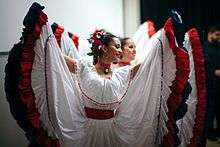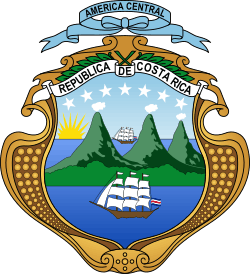Music of Costa Rica
The country of Costa Rica has many kinds of music.
| Music of Costa Rica Topics | ||
|---|---|---|
| Calypso | Rock | |
| Soca | Rumba | |
| Reggaeton | Hip hop | |
| Pop | Cumbia | |
| Merengue | Salsa | |
| Bachata | Classical music | |
| Tex-Mex | Guanacaste | |
| Marimba music | Folklorico | |
| Afro-Caribbean music | Metal | |
| Punk | Ska | |
| Timeline and Samples | ||
| Central American music | ||
| Belize - Costa Rica - El Salvador - Guatemala - Honduras - Nicaragua - Panama | ||
Though its music has achieved little international credit, Costa Rican popular music genres include an indigenous calypso scene, which is distinct from the more widely known Trinidadian calypso sound, as well as a thriving disco audience that supports nightclubs in cities such as San José. American and British rock and roll and pop are very popular and common among the youth (especially urban youth), while dance-oriented genres including soca, salsa, merengue, cumbia and Tex-Mex have an appeal among a somewhat older audience.
Mexican music is very popular among older people and some people in the countryside. During the middle years of the 20th century, Costa Rica was exposed to much Mexican cultural influence.
Folk music

The Caribbean coast shows a strong African influence in the complex percussion rhythms such as sinkit. Like its northerly neighbors in Central America, the marimba is a very popular instrument, and Costa Rican marimba music is very popular. In modern times, groups such as Cantares have helped to popularize Costa Rican folk music, and were a leading part of the New Costa Rican Song movement .
Costa Rica's pre-Columbian population has contributed a large part of the country's folk heritage, include rare musical scales, certain ceremonial songs and ocarinas. The Guanacaste region, in the Nicoya Peninsula, is home to the best-known folk traditions. Along the Atlantic coast, the African musical heritage is more pronounced, and Afro-Caribbean music including rumba, calypso and reggae are popular.
In most of Costa Rica, ancient instruments such as ocarinas are being replaced by international instruments such as accordions and guitars. There are still folk styles, even outside of Guanacaste, such as the Talamanca's Danza de los Huelos and the Boruca people's Danza de los Diablitos.
Guanacaste is the major center for Costa Rican folk music, especially pre-Columbian styles such as the Danza del Sol and Danza de la Luna of the Chorotega, who also popularized the ancient quijongo (a single-string bow and gourd resonator) and native oboe, the chirimia .
Costa Rica's population never developed a major rhythm or style that became a major part of popular music. The Andean peña tradition (an international gathering of like-minded persons) is strong in Costa Rica as well, introduced by immigrants from Chile and Argentina.
In the late 1980s some local artists and bands became famous for having their own style and original material, such as José Capmany, Distorsión, Café con Leche, Modelo Para Armar and Inconsciente Colectivo. Some of them had fans from outside of Costa Rica, such as Editus, a Grammy winning contemporary jazz ensemble. At around that time a popular Latin genre developed, chiqui chiqui, a mixture of merengue, cumbia and other Latin rhythms along with afro-pop influences led by bands such as Los Hicsos, Jaque Mate, La Pandylla, Manantial and La Banda. After losing popularity around the 1990s, chiqui chiqui has resurfaced and established itself as one of the most popular and recognizable music among Costa Ricans, thanks in part to the release of CD re-editions of many classic hits. Some examples of Costa Rican chiqui chiqui hits are:
| Bands | Song | Year |
|---|---|---|
| La Banda | Avispa (Suavecito) | 1978 |
| Los Abejorros | La Fiesta | 1982 |
| La Banda | Panamá Me Tombé | 1982 |
| La Pandylla | A Comer Mamey | 1985 |
| Marfil | Menealo | 1985 |
| Jaque Mate | El Pipiribao | 1985 |
| Blanco Y Negro | El Güiri Güiri | 1986 |
| Jaque Mate | El Cangrejo | 1986 |
| Manantial | Julieta | 1986 |
| Marfil | Represento | 1986 |
| La Banda | La Pastilla Del Amor | 1987 |
| La Maffia | Con Medio Peso | 1988 |
| Los Alegrísimos | El Delicuente | 1988 |
| La Empresa | Latino Soy | - |
| Los Hicsos | El Hula Hula | - |
Rock music
From the late 1990s to the present time, there has emerged a newer local rock style led by bands such as Gandhi, Evolución, Tango India, Suite Doble, Alma Bohemia, and Kadeho, all of which have been accepted positively by Costa Rican youths. There are Metal bands, including Grecco, Advent of Bedlam, Corpse Garden, Norko, Catarsis Incarne, Heresy, to name but a few. The rock bands began a new standard for Costa Rican music with bands such as Time's Forgotten, Pneuma and Sight of Emptiness making highly produced albums and concerts. Also bands venturing into Reggae and Ska are popular, one example is Mekatelyu and Michael Livingston.
Costa Rica has become a centerfold for international rock and heavy metal concerts. According to sponsors and the Flight 666 documentary, Iron Maiden's 2008 Costa Rican stop of their Somewhere Back in Time World Tour was the largest in Central America, with over 27,000 attendants. Since that concert, Costa Rica is now becoming an important stop for metal bands.
Malpaís, a band emerging from the Guanacaste-area, is one of the main bands of the Costa Rican rock and music scene, mixing traditional Costa Rican folk and Latin music with jazz and rock and has met great success in Costa Rica and surrounding countries. Cantoamérica is a band led by Manuel Monestel that for many years has developed research and promotion of the music of the Costa Rican Caribbean coast. Calypso music and other caribbean sounds are included in the band's repertoire. Cantoamérica has traveled all over the world as ambassador of Afro Costa Rican music.
Music institutions
Classical music performing organizations include the Costa Rican National Symphony Orchestra (or its Spanish acronym OSN), formed in 1970, it is part of the Ministry of Culture of Costa Rica and the oldest and most important orchestra in the country. It has its headquarters in the province of San José. The orchestra has been conducted by Americans Gerald Brown and Irwin Hoffman, followed by the Japanese Chosei Komatsu. In 2014, Carl. St. Clair assumed the position as music director . The country is also home to an opera company, one of the first professional choirs in Central America, and a state-subsidized youth orchestra, which belongs to the National Symphony Orchestra. The Universidad de Costa Rica has a concert band and an orchestra, besides an early-music group and several chamber music groups.
The National University, Universidad Nacional, has a resident string quartet and a symphony orchestra, which had its very successful premiere at the National Theatre in San José on May 10, 2007, conducted by Dieter Lehnhoff. It has also a highly successful piano school led by the Russian virtuoso, Alexandr Sklioutovsky. Other well-known groups are the El Café Chorale and the Sura Chamber Choir and also the pianist Ismael Pacheco, who was the second Costa Rican pianist to have been performed at the prestigious Carnegie Hall in 2001 and also at the Musikverein in 2007 .
Both the Universidad de Costa Rica (UCR), in San José, and the Universidad Nacional (UNA), in Heredia, have well-structured programmes in Music, where students can pursue bachelor's degrees in instrumental and vocal performing, composition, and conducting. The latter also has a doctoral degree in Central American Arts and Letters, with an emphasis in Music.
Contemporary composers include Mario Alfagüell, Marvin Camacho, Alejandro Cardona, Bernal Flores, Benjamín Gutiérrez, Luis Diego Herra, and Eddie Mora, to name but a few.
Costa Rican folk institutions include the Fantasía Folklorica. Every August, Costa Rica is home to an International Festival of Music.
In recent years the government, led by the Ministerio de Cultura, has aimed to revitalize traditional Costa Rican music.
References
- 89decibeles.com is a costarrican online magazine about alternative music and pop culture.
- FuenteRock.com is the Costa Rica rock website, here you can find info about practically any Costa Rican Rock Band
- Vibratica.com is a Social Network that promotes Costa Rican Music
- Time's Forgotten Official Website
- National Artist Debi Nova
- Benjamín Gutiérrez Sáenz Project (Dedicated to Costa Rica's Contemporary Music)
- LA RETRETA, Academic Music Magazine of Costa Rica
- Costa Rica Music Festival
- Costa Rica Arts & Culture
- adondeirhoy.com is an official site for information on Costa Rican music and local bands.
- Ismael Pacheco Official Website
- Grupo MalPais Official Website
- José Daniel Zúñiga, National Folk Music Composer
- Events Calendar of Costa Rica
- Costa Rica's National Symphony Orchestra Official Website
- Ópera De Cámara de Costa Rica
- Anayanci Quirós, Costa Rican Soprano
- Peregrino Gris Official Website
- Papaya Music Record Label
- Hotel de la música Costa Rica, music sessions
- Orange County's Pacific Symphony Director's Bio
- Orquesta Sinfonica Nacional
Articles
- [Campos Fonseca, Susan: "Historia compensatoria y Filosofía: Un caso centroamericano", en BABAB, Nº33, verano, España, 2008, ISSN · 1575-9385. Disponible en: http://www.babab.com/no33/susan_campos.php]
- [Campos Fonseca, Susan: "'Com-poner' la historia sonora de un país". Disponible en: http://www.susancampos.es/blog/report-costa-rica/]
